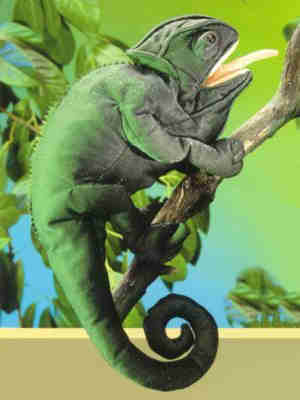|
|
The Veiled Chameleon (Yemen Chameleon - calyptratus
calyptratus and C. calyptratus calcarifer) are the species
of chameleon most often seen in pet stores, and they are
widely bred in captivity now so you should have little
trouble finding a captive bred specimen of this crested,
highly colored and dramatic-looking lizard.
The basics you will need to provide for your chameleon will
be a tall cage with perches, dedicated heat and lighting, a
dripping water source and varied insects for food. In this
article we will advise you about planning your Yemen
Chameleon's cage, and other articles will address other
needs.
When planning the home for a future pet, the first
consideration is to learn about the natural environment of
the species, and then to try to replicate it as much as
possible so that the animal has what it needs for health and
happiness. In the case of the Veiled
Chameleon, that natural
environment is southern Saudi Arabia and western Yemen, in
the oases and other naturally well vegetated and humid
areas.
Although Saudi Arabia and Yemen are primarily desert
countries, so even the oases don't get that much rain, the
humidity in the oases is high and Veiled Chameleons gather
around pools of water from mountain runoff and the like
since they are insectivores and more insects are found near
the pools, so water plays a large part in their lives.
These chameleons are found most of the time in the trees and
bushes and are excellent climbers. In the mornings you can
usually find them basking in the sun to warm up from the
night, as in that part of the world most of the year has
very hot days and dramatically cooler nights. These
chameleons get most of their water requirement by licking
dew off the vegetation as it runs down the leaves and stems,
and the droplets running down instinctively inspires them to
drink.
In captivity, the enclosure for a Veiled Chameleon will need
to be a screen cage at least two by two by three feet tall,
with a tight fitting lid. The taller the cage the better,
for more climbing space, especially for the larger adult
males. Put the cage on a stand or table to give your
chameleon even more of a feeling of being in the trees and
it will be less stressed.
Note: It is a bad idea to put more than one Veiled Chameleon
in a cage, or even in a different cage within eyesight of
each other or even other animals. These lizards are so
territorial that they can even be stressed by their own
reflection in the glass of an aquarium tank.
The cage will need live nontoxic plants such as Pothos,
Schefflera, Bougainvillaea, Hibiscus and ferns, (Adult
chameleons will eat the vegetation, even if it's plastic, so
better make it edible!) and sturdily placed branches for
climbing and basking. Try to arrange the climbing branches
at varying levels with an easily-climbed pathway of branches
from the cage bottom to the top basking branch under the
basking light.
When planning the cage, plan where to put a full-spectrum
reptile UVB light (for adequate Vitamin D3 production) and a
basking/warming light at the top of the cage but arranged
with the climbing branches so that there is no possibility
that your chameleon can burn itself on the lights, but don't
put glass or plastic between the lizard and the lights or
the UVB will be blocked. Burns are the main cause of injury
in captive chameleons; apparently they don't feel themselves
burning.
Young chameleons will do well with a sixty watt basking
bulb, but adults should have a bulb that is seventy-five to
one hundred watts. A basking temperature just below one
hundred degrees Fahrenheit (thirty-seven degrees Celsius) is
excellent, with the bottom part of the cage cooler so the
lizard can regulate its body temperature by moving from
bottom to top or top to bottom. Check various areas of the
cage with a thermometer to make sure the temperatures are
right and there is a range of choices for your lizard. If
your home doesn't get colder than fifty degrees F. (ten C.)
at night, set a timer to turn off the basking light in the
evening. Veiled Chameleons are used to a good day/night
temperature variation and it is good for their health.
Be sure to water and mist the live plants daily to keep the
plants healthy and the humidity in the cage high (between
fifty and sixty percent.) Misting is also good for your
chameleon, and encourages it to drink. These chameleons
won't drink from a water dish; you'll need a drip system as
discussed elsewhere on this site.
Veiled Chameleons are stunning, hardy and unusual pets, give
yours proper care and you should enjoy his antics for many
years.
Lively Stuffed Plush Chameleons

|